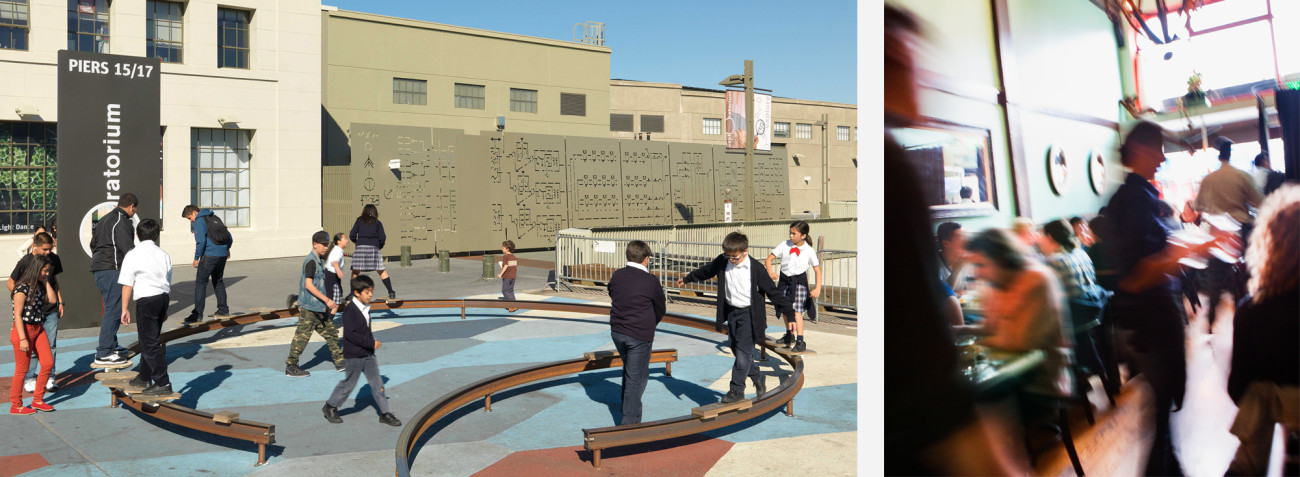The tugboats are moving, the dredges are working, and today Exploratorium officials will host a groundbreaking ceremony on a $300 million project that will transform two huge piers on the Embarcadero into a new home for the hands-on science museum.
Construction of the new Exploratorium on Piers 15 and 17 along San Francisco’s northern waterfront has already begun. In three years, the first stage, on Pier 15, will provide vastly expanded space for the museum’s exhibits, classrooms and teacher-training facilities, which have outgrown their current site at the Palace of Fine Arts in the Marina.
Plans for expansion on Pier 17 will follow.
Large public promenades with dramatic views of the bay and the city’s skyline will replace the aprons of the dilapidated piers and add a unique marine environment to the museum for observing, experimenting and contemplating life forms in the bay waters.
When the museum opens on Pier 15 in 2013, oceanographic research vessels will be able to dock there. Researchers aboard the ships will be able to relay science data freshly acquired from the open sea to the Exploratorium’s staff on shore for translation to visitors and to share with museums around the world.
“We can’t be sitting right on the water here without doing water science as well as the exciting science we do indoors,” said physicist Dennis Bartels, the Exploratorium’s executive director, during a recent interview. “It will be a ball explaining the wonderful microbial life that exists around us and helping all kinds of people to slow down and understand the fog and the wind and the tides. There’s a whole ecosystem made visible for us.”
So far, a capital campaign, headed by George W. Cogan, chairman of the museum’s board, has raised $209 million from private donors and is seeking $91 million more to complete the Pier 15 job.
Nine-acre campus
Ultimately, Piers 15 and 17 will form a 9-acre science campus under a 66-year lease with the Port of San Francisco, Bartels said.
The current Exploratorium, where kids and adults have played together for more than 40 years, will remain where it is until its new home at the foot of Green Street is complete, he said.
Cogan, a Palo Alto-based physicist and vice president of the global consulting firm Bain & Co., has been fascinated by the Exploratorium since he moved here more than 20 years ago. He has been on the museum’s volunteer board for more than a decade.
“This is an institution marked by excellence, and our new home will give us a tremendous opportunity to rethink and reinvent the way it interacts with the world around us and encourages more people to engage their curiosity and think about the world for themselves,” Cogan said.
Already the BayDelta Maritime tugboat fleet has moved from Pier 15 to the adjoining Pier 17, and dredging has begun to cleanse the bay bottom between the two piers. Engineers will soon be driving piles as deep as 160 feet to strengthen the decrepit structures and seismically upgrade them.
The Exploratorium opened in 1969 as a museum of “art, science and human perception,” as its founder, the late Frank Oppenheimer termed it, and it has long focused on explaining new “green” environmental technology.
Solar power
The new building on Pier 15 will continue that tradition, Bartels said, with a 1.4-megawatt solar collector on the roof fulfilling the museum’s electricity needs. Bay water, pumped through a heat exchanger, will heat and cool the building, and some of the rainwater collected on the rooftops will be reused for toilet flushing, and the rest filtered and returned to the bay.
Those approaches mark a striking difference from the history of the piers, which were built nearly a century ago to serve shipping lines and later served as trucking terminals. Both served troops coming home from World War II, but for many years they have gradually been deteriorating.
“I have no doubt that the Exploratorium will fast become a new icon on our city’s waterfront, connecting new generations of residents and visitors with the wonders of science and our environment,” said Mayor Gavin Newsom in a statement. “This is a model public-private partnership that will both revitalize crumbling piers and reinvent the Exploratorium experience.”
Read the original story here.
